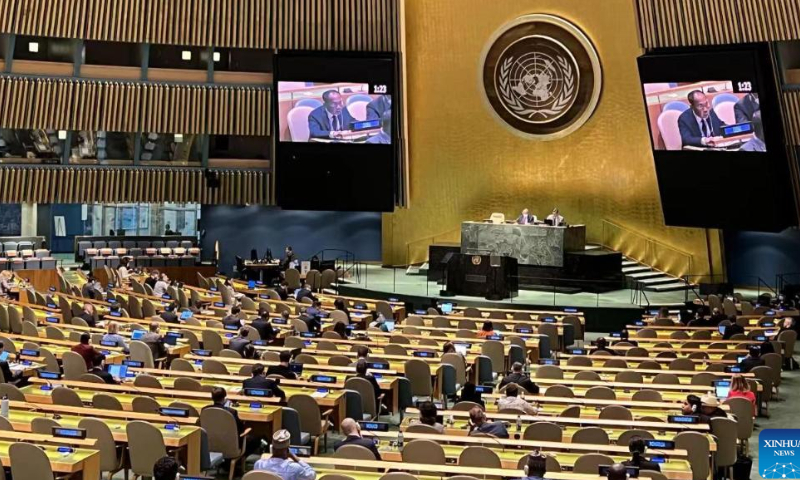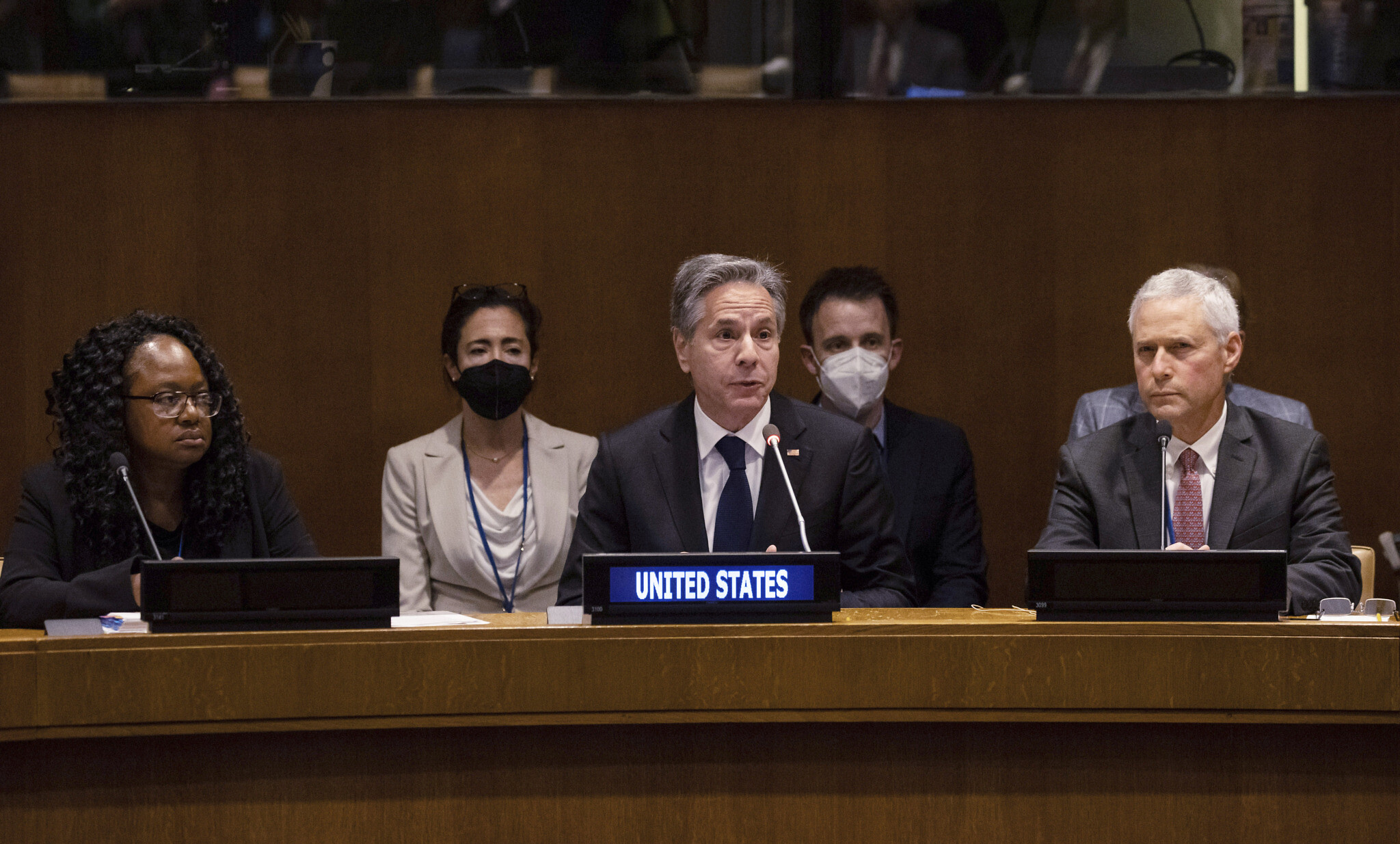
The Myth of the Middle
Ray Acheson / Reaching Critical Will
NEW YORK (August 20, 2022) — As the third week of the NPT Review Conference (RevCon) drew to a close, none of the three Main Committees had reached consensus on their draft texts. This is not unusual; intensive negotiations always happen during the last week of the Conference. But the frustration of many delegations — particularly in Main Committee I (MCI) — was clear.
Once again, nuclear disarmament is the crux of the matter and the fate of this Review Conference hangs on the 50-year-old question: to comply with Article VI or not to comply?
(Or it could hang with the outcome of Subsidiary Body 2. As in past RevCons, that draft text, which deals with the Middle East, still has not been released, but its contents have crashed RevCons before — see: 2015.)
Either way, the success of the RevCon — measured for us at Reaching Critical Will not through the adoption of an outcome document but on the meaningfulness of that outcome and its implementation — depends on whether or not NPT states parties are willing to follow through on their legal obligations and on the commitments they have agreed by consensus in the past.
Ambition vs. Interpretation
In 2019, the Chair of MCI (who was then Chair of the Preparatory Committee) oversaw the development of bold set of recommendations for this RevCon. These included calls for concrete and measurable steps to reduce that alert status, risks, and roles of nuclear weapons, to cease nuclear weapon modernization programs, and to commence negotiations to eliminate nuclear weapons.
Nothing like this is reflected in the merged MCI report issued on Friday. There are no timelines or benchmarks, other than the external deadline of renewing the New Strategic Arms Reduction Treaty before it expires in 2026. There are no calls to stop the qualitative or quantitative development of nuclear weapons. No calls to begin negotiations for nuclear disarmament as mandated by Article VI.
The reference to states in nuclear alliances having a responsibility to reduce the role of nuclear weapons in doctrines has been deleted. The few places where the word “measurable” appears were jumped on by France and the United Kingdom, which demanded their removal.
The nuclear-armed states objected also the descriptions of the humanitarian impacts of nuclear weapons, and even to the most benign factual reference to the Treaty on the Prohibition of Nuclear Weapons (TPNW). As described in earlier editions, they demanded the conditioning of all past commitments against the international security environment and objected to any language that suggests they have any responsibility for creating that environment.
In reacting to the latest MCI draft on Friday, France and the United Kingdom asserted that the text engaged in “selective interpretation” of past commitments and Article VI. They demanded the deletion or rewriting of multiple paragraphs because of this. Yet all of the nuclear-armed state contributions to this text have been to selectively interpret their obligations.
They want praise for their twelve years of work on a glossary of nuclear terminology — which was not something NPT states parties ever even requested they create. Most sought to condition their implementation of Article VI and rewrite its meaning, with three going so far as to argue that the International Court of Justice’s ruling on their nuclear disarmament obligations is incorrect.
One has opposed any reference to the fact that it has made nuclear threats or violated security assurance agreements, while some of the others only want to condemn certain kinds of threats that they see themselves as too “responsible” to make.
All of the nuclear-armed states approach nuclear disarmament as something that will hurt them. They seem to perceive non-nuclear armed states as demanding actions that will result in an existential threat to their survival as states. France, for example, said that its suggested amendments, or rather, demands, for the draft are not cosmetic but reflect “very sensitive national concerns”. In this context, apparently even mentioning that the TPNW exists is a national security concern to France.
But for the non-nuclear armed states — the ones that are not in military alliances that include nuclear weapons in their security doctrines — nuclear disarmament is one of the best ways to help increase global security. And it is the only thing that will prevent the use of nuclear weapons, end the vast expenditure on modernisation, and end the risks of nuclear war.

What “Middle Ground”?
On Friday, Austria said it is disappointed that the nuclear-armed states aren’t prepared to agree to concrete steps for tangible progress on nuclear disarmament. It asked, what changes the day after this document is adopted?
Many other delegations expressed their frustration with the lack of ambition in the draft report, as reflected in the summary of the MCI meeting in this edition. The world is at risk, but the wording of the MCI draft — and the nuclear-armed state approach to it — suggests everything is fine. As South Africa said, the provisions in the draft seem to indicate that it’s fine for the nuclear-armed states to continue to possess nuclear weapons, they just need to exercise care here and there.
The only states that seem happy with this current draft are the nuclear-allied states. Several welcomed the Chair’s efforts and said this draft strikes a good “middle ground.”
It’s interesting to put this in context of their reaction to the recommendations from the 2019 PrepCom noted above. At that meeting, they accused this same Chair of “drifting away from consensus” and supported the nuclear-armed states that even accused him of “undermining the NPT.”
In that meeting, most of the nuclear-allied states actively worked to protect the radical extremist view of the nuclear-armed states that every nuclear disarmament agreement made in the NPT context for the past 50 years is no longer relevant because of the “security environment.”
This raises the question (which we have asked many times before) — what is the middle-ground between a few dozen states that support nuclear weapons and all of the other states in the world that do not? Why do states that have rejected these weapons of genocidal violence need to “compromise,” if what compromise means is accepting the continued existence of weapons of terror that can unleash generations of radioactive poison, that can destroy entire cities and contaminate land and water — that can annihilate all of humanity?
What is the “middle ground” between compliance with one’s legal obligations and non-compliance? Why should the world have to accept the nuclear-armed states refusing to implement their obligation to commence and conclude negotiations to end the arms race and achieve nuclear disarmament?
Why is it considered “middle ground” to allow the nuclear-armed states to continue to possess, to upgrade and expand, and threaten to use nuclear weapons more than 50 years after they pledged to eliminate them?
The Philippines warned that the “business as usual” attitude to the implementation of past commitments is “unsustainable and anachronistic,” especially in light of the current geopolitical situation.
The NPT is not a game or a theatrical performance. It is a legally binding treaty. But 50 years after its entry into force, we are still waiting for Godot. Still waiting for the nuclear-armed states to do what they said they would do when they put pen to paper and ratified this instrument. This is not reasonable, rational, or credible — and it cannot continue.
Note: Download full edition as a PDF
Posted in accordance with Title 17, Section 107, US Code, for noncommercial, educational purposes.